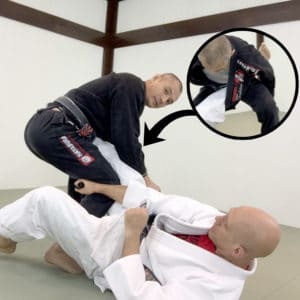Are you coming from a background in submission grappling or training mostly without the gi and trying to get into BJJ?
Are you frustrated by the cloth prison (the gi) that’s stifling your movements and allowing your opponent to wrap you up?
I’m a big fan of being competent in both gi and no gi grappling, if for no other reason than self defense.
Yes, you might get attacked on the beach when you’re only wearing speedos or board shorts. But most self defense situations occur when you’re wearing clothing that someone can grab onto. (Not to mention that YOU might want to use someone’s own clothing against them in a real fight too).
But the gi can be very tricky at first, and a lot of people give up in disgust before they figure it out.
Here’s a video with my 5 top pieces of advice to make dealing grappling with the gi on much easier…
Let’s go through the 5 points in the video one by one and give you a few more resources for more information…
1, Learn to Manage and Break Grips
If you allow your opponent to get his preferred grips with the gi you’re going to have a very rough time! You’ll be swept all over the mat, have your guard passed, and be wrapped up faster than a last minute Christmas present!
There are lots of different kinds of grips but you should start by learning how to deal with the most common ones first. The most common grips in the gi are:
- Lapel grips
- Sleeve grips
- Belt grips
- Pant grips
The video above showed you some examples of basic grip breaks. Covering all possible grips and specific breaks for each would be a gigantic project (‘Gripbreaking Masterclass’ anyone?) but for now I’m happy to show you a few additional high percentage breaks…
Breaking the cross collar grip from closed guard…
Breaking a sleeve grip standing…
Breaking a belt grip…
Learning how to break different grips correctly is probably the single biggest thing you can do to get better at gi based grappling. So don’t skip or overlook this step!
2, Develop An Awareness of the Gi-based Guards
Most types of guard are reasonably similar in gi and no gi.
But there are some guards that are basically only possible with the gi including…
- Collar-sleeve closed guard
- Spider Guard
- Lasso Guard
- Lapel and sleeve control forms of de la Riva Guard
- Worm Guard
- Lapel Guard
- etc.
In jiu-jitsu it’s what you don’t know that often kills you, so you should do a little bit of exploration of these gi specific guard positions, just for familiarisation purposes.
I’m NOT saying that you need to become an expert in the upside-down, inside-out, reverse de la Worm Guard. We’ll leave that to the Keenan Cornelius’s of the world.
But the easiest way to learn to defend something is to first learn how to do the basics of it yourself. So that’s what we’re interested in initially: just the basics, and just enough for you to recognise these weird entanglements and see them coming.
Then, down the road, who knows… Maybe you’ll really take a liking to the Collar-Spider Guard or some other lapel dependent guard and base your entire game around it.
Or maybe you’ll find ways to adapt the position to no gi and take the grappling world by storm.
Here’s an example of a position that has historically mostly been used for gi grappling: the de la Riva Guard.
The first video below – which I shot a few years ago – focussed on the four major gi grips used to control the de la Riva…
- Cross Sleeve Grip
- Lapel Grip (and Belt Grip)
- Same Side Sleeve Grip
- Double Sleeve Grip
But then despite the historically heavy emphasis on gripping sleeves and lapels in this guard, the game evolved.
People like Rob Biernacki figured out a system for using the de la Riva Guard in No Gi, using heel grips and leg positions to offbalance the other other guy, transient arm grips to set up submissions, and combining it with other types of guard that work really well in no gi.
Anyway, it just goes to show you that a little bit of exploration of the gi world can allow you to bring back some gold to the realm of no gi!
3, Develop Awareness of Gi-based Submissions
Armbars, guillotines, rear naked chokes, Kimuras, ankle locks and omoplatas are very similar gi to no gi. There’s a ton of crossover.
But the gi does offer you a TON of submissions – mostly chokes – that are almost impossible to get in no gi.
So just like you needed to familiarise yourself with the gi-based guard positions, you ALSO have to learn the most common gi submissions.
There are almost too many gi submissions to list, but some of the most common ones are below…
Cross Choke from Mount
Clock Choke vs Turtle
Sleeve Choke from Top Position
The Bow and Arrow Choke from the Back
4, Become Accustomed to the Slower Pace of Gi Grappling

With the abundance of grips in gi based grappling it’s a little easier to stall and slow things down.
If you’ve facing an opponent who’s jumping all over the place like a spider monkey on crack then, if you can get a solid set of grips, you can often hold him in place long enough to nullify his athleticism.
So that creates a generally slower pace in a match, where it’s relatively common for both participants take short breathers and try to figure out their next move.
Now that’s a generality of course – there are definitely dynamic fighters in the gi and slow, methodical, boring fighters in no gi.
But if you’re a no gi fighter relying on your scrambling ability to get out of difficult situations then you might be in for a bit of rude shock when you slip on a Kimono. An experienced opponent is going to get his grips and slow… you… down…
Now the better you get at grip management the more dynamic you can be in the gi, so this isn’t an insurmountable problem.
You just need to know that it’s one of the challenges you’re going to face in the gi and accept it.
Which brings us perfectly to the final piece of advice…
5, Learn to Embrace the Gi as a Puzzle to be Solved

It’s been said that if no gi is checkers then gi-based grappling is chess.
I think that’s a bit of an oversimplification – there can be some tremendously sophisticated strategies and techniques in no gi grappling, but there’s still a grain of truth to that analogy.
In the gi there simply are so many more gripping, control, sweeping and submission options that legitimately is a more complicated game.
Here’s the thing though…
Mindset is critical!
Thinking of the gi as a puzzle or game to figure out, rather than a f@#$@#% problem, will help you get better SO much faster.
It’s a puzzle, sure, but there are solutions! Other people have figured it out and so can you!!
Start with the advice above, learn a few ‘gi based answers’ to the most common ‘gi based problems’.
Then learn a few gi-based attacks of your own. You don’t want to let your opponent have all the fun, do you?
(This quote comes from the Brandon Mullins Episode of The Strenuous Life Podcast that I produce.)
Good luck with adding the gi to your training.
With the right techniques and mindset this doesn’t need to be a horrible experience – it can be a fun challenge that will actually make you a better, more well rounded grappler!
Stephan
The post Dealing with the Gi in Grappling appeared first on Grapplearts.

